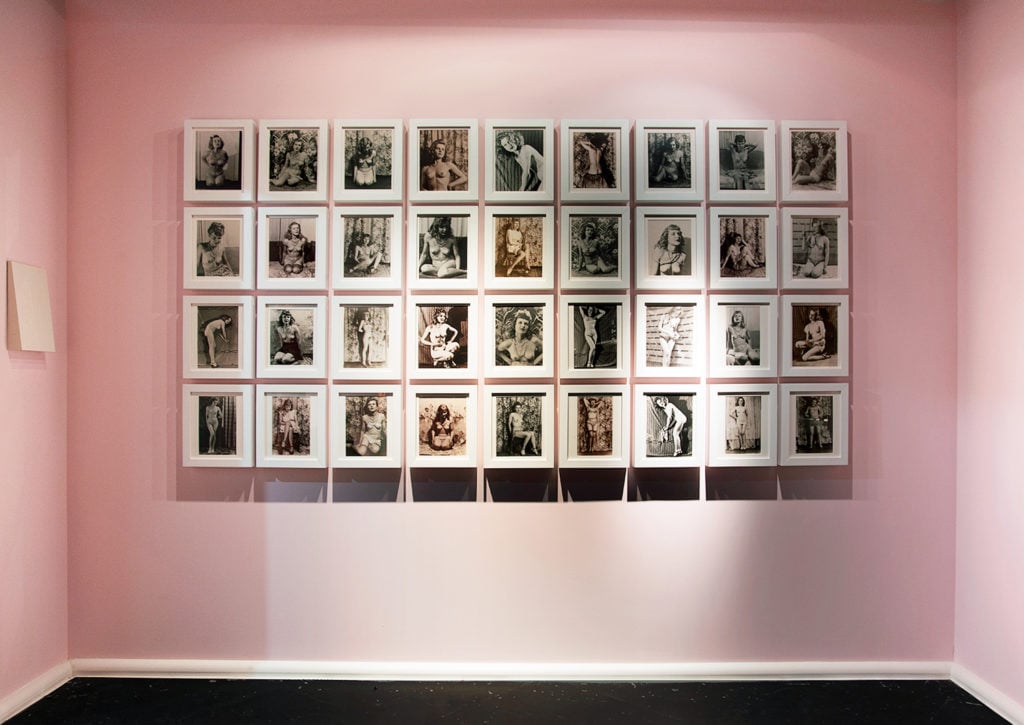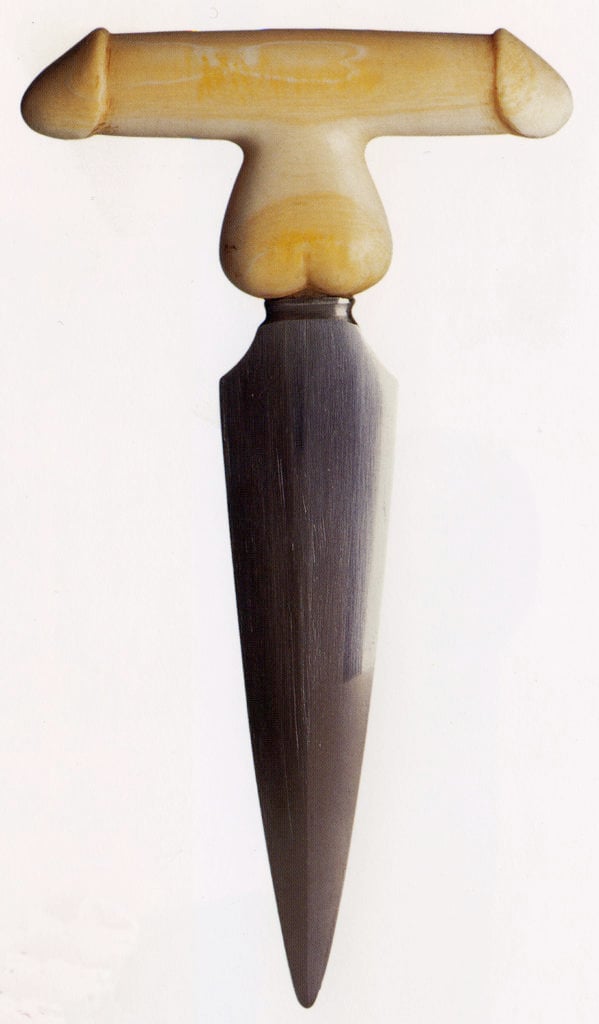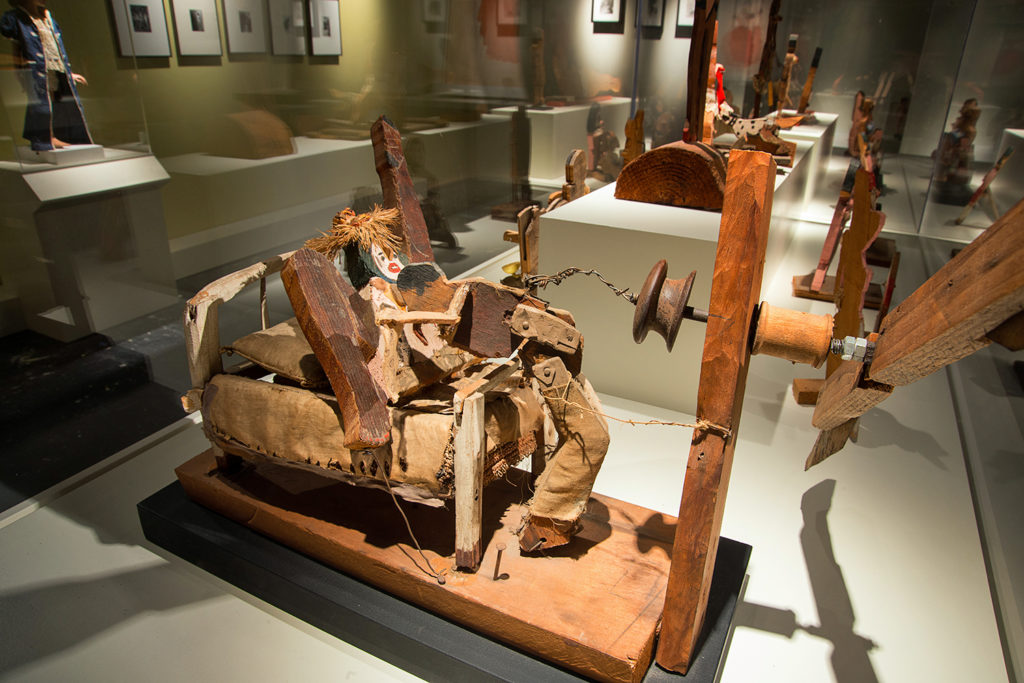Art World
Bringing Sexy Back: Private Obsession and Hidden Desire at the Museum of Sex
An intimate show does “Desire” the way Deitch and Gagosian didn’t.

An intimate show does “Desire” the way Deitch and Gagosian didn’t.

Laura van Straaten

Desire is a funny thing. You never know where or how it will be provoked. And it’s hard to manufacture.
One place it was not was the Larry Gagosian-Jeffrey Deitch debacle named “Desire,” curated—if you could call it that—by Diana Widmaier-Picasso. That’s because the show, which opened during the recent art fairs in Miami, lacked intimacy in every way.
I’m almost always game for a bit of prurience. Who doesn’t like a little dirty-mindedness now and then? But I, along with my half-dozen art-week running buddies (collectors, artists, curators, journalists, dealers—including one who works for one of the exhibit’s organizers), found “Desire” crass. It was also irredeemably commercial, particularly since the exhibition was sited—as was last year’s Deitch-Gagosian production—in the Moore Building in Miami’s design district with mega global brands like Dior, Lanvin, and Prada as its immediate neighbors.
To be sure, there were many wonderful individual works on view. Juergen Teller’s 2008 photograph “Octopussy, Rome,” depicting an octopus on rumpled bed sheets, was a delight amidst floor after floor of images of naked humans and fucking. I suppose any show that I’m still annoyed about more than a month later can be described as impactful. And they say hate and love are two sides of the same coin.
But the flipside of desire? Aversion, revulsion, repulsion. And those are what my merry band felt building as we toured the mass of artwork by more than 50 artists on view, particularly when we hit—maybe halfway through—Urs Fischer’s “live installation” of nude people. One woman’s entirely bare vagina was marred by what looked like recent bruising and scarring from her efforts to denude herself of public hair. What really lost us was the series of Noritoshi Hirakawa’s “Dreams of Tokyo,” with its 20 photographs of attractive young Japanese women in skirts or dresses squatting on the street without underwear—which may be powerful in a different context. The overkilling aggregate of this the show-cum [pun intended]-spectacle felt lewd, no matter your gender or sexual orientation.

Royal Robertson, Untitled (The Ten Commandment Laws or Dustdard Sinfulness Farm) (1980). Courtesy of Andrew Lemeshewsky, Jr. and Shrine Gallery, NYC
By contrast, “Known/Unknown: Private Obsession and Hidden Desire in Outsider Art,” which opens to the public on January 19, is an intimate, articulated exhibition with a clear curatorial point of view that is filled with humor and revelations about human sexuality and quirk.
The show is the result of a cold call from a curious curatorial assistant, Lissa Rivera of the Museum of Sex (MoSEX), to Frank Maresca of the New York gallery Ricco Maresca, known for its longtime representation of “outsider” artists. “I’d been interested in outsider art and the work Frank represents for quite some time,” Rivera says. Maresca had to admit that even though the museum is coming up on its 15th anniversary, and he lives a block away, “I had never been inside.” Still, he was intrigued.
“I knew an outsider exhibition with the theme of sex had never been done anywhere in the world, ever,” says Maresca. Ultimately, he suggested having the show open this week alongside the Outsider Art Fair, in which he has participated since its founding 25 years ago, as its first-ever concurrent museum programming.
The exhibition’s unusual warren of space features more than 100 photographs, sculptures, paintings, and other objects, many of which were found after the deaths of their creators and had likely never been intended for any “use” (get your mind out of the gutter!) other than private. So the eroticism is heightened for the visitor in knowing that these objects were not meant to be seen. Indeed, many may not have been considered by their makers as art objects at all.
The show is composed entirely of loans from private collectors, including many of Maresca’s own clients. “None of this work has ever been exhibited in public,” he says, “Until now.”
Overt sexuality and eroticism are, perhaps surprisingly, not typical subjects in this type of art, according to Maresca. But when they are, they are broached in a way that is unselfconscious.
Another way to put it is, when these artists fly their freak flag, they fly it high. And the show is intended to exude a deep “empathy for the artists,” as Rivera, who explores eroticism and gender in her own artistic practice, puts it.
The artists here include the self-taught, the eccentric and those who struggle with mental health issues. Many of the works are by unknown artists, like the dozens of delicate, handmade ceramic dolls from the 1950s or ’60 that Maresca said are inspired by Barbie, who herself was modeled on an erotic doll. Much of the art was created in seemingly unlikely situations. Artist Gil Batle’s studio is a prison, where he carves elaborate fantasies onto ostrich eggshells 1/16 inch thick. The Austrians Johann Korec and Johann Garber, whose watercolors and ink-on-paper sketches are, respectively, on view here are roommates in a psychiatric hospital. They are part of the Vienna-based Gugging Artist Group, a live-in-artist colony of long-term in-patients who are invited because of their artistic abilities and allowed—contrary to most art-therapy approaches—to give free reign to fantasies.
In brief, everything that was missing from the “Desire” show last month in Miami is here in full force. As Maresca explains, “This show is almost a statement against the commodification of art today.” While the 20 black and white photos by Massimilano Gioni favorite Morton Bartlett will likely get a lot of attention, these are the highlights that most spoke to me:

Unidentified Maker. Erotic Dagger, ca. 1870-1880. Ivory, steel blade. 5.5 x 3 x .75 in. Courtesy of Ricco/Maresca Gallery.
1. With misogyny in the air and starting Friday in the Oval Office, a woman may need to protect herself. What better way than a steel dagger whose handle is shaped like two tiny, well-formed penises? But wait, there’s more! No dildo-handed dagger is complete without a velvet-lined leather case monogrammed with one’s name! I’d call now to order if only more than one had been made; the dagger is thought to have been a custom gift for self-protection to a prostitute named Rebecca in or near Philadelphia in the 1870s or 1880s. It is on loan from John and Barbara Wilkerson (best known for their collection of aboriginal art), along with several other pieces on view, including what Maresca says is “one of the finest examples of an erotic cane.” (There’s a genre for that? How can you not admire human ingenuity?)
2. A pastel-pink painted room houses a tightly assembled collection of Eugene Von Bruenchenhein’s erotic black and white prints of his wife Marie, who comes across as game, and whom the curators consider a co-creator of the work. “They were each other’s world,” says Maresca, “They were mutual muses.” Indeed, after Eugene’s death, Marie consented to the work being seen in public. (Unlike most of the artists here, he had tried in vain for public recognition of his work.) The pictures recall 1940s pin-up poses while conveying a loving playfulness between the photographer and his subject, who were married for nearly 40 years and lived in Milwaukee where he worked as a baker. What makes them intimate and sexy are the homemade, sometimes hokey, aspects of the set–up. She appears in various states of undress against varying theatrical backdrops of floral fabric, with diverse arrangements of pearls dipping between and over her breasts, which seem to be the focal point in all but three of the more than 30 images on view. (“I like to call them bondage pearls because that is what they are,” says Maresca). Some days Marie sports a refined coif and on bad hair days, bushy bangs and a certain crumpled quality of the up-do suggest the couple may not have been able to wait until the shutter clicked to get down to business. A show of color slides bring the couple’s artistic practice to life on an adjacent light box while a passionate and silly song “I Love Marie” by EVB provides an audio backdrop. All the images are on loan from Chicago-based collectors Lewis and Jean Greenblatt.

Steve Ashby. Untitled (Rocking Bed Cunnilingus Whirligig), ca. 1965-70. Wood with polychrome and metal parts. 13 1/2 x 20 3/4 x 22 in. Courtesy of Ricco/Maresca Gallery (Bob Roth Collection).
3. But every woman’s favorite will be an untitled Steve Ashby sculpture that the curators refer to as “Rocking Bed Cunnilingus Whirligig.” It’s a “wind-powered” tabletop sculpture designed so that a drive shaft causes the male figure with a protruding tongue to move up and down on a woman spread-eagled enthusiastically at the edge of a fully dressed bed.
Ashby, born in 1904, did not begin making art until his wife died in 1960 and he’d retired from farm work in rural Virginia where he spent his whole life. Some of the 20 painted plywood and tin pieces on view explore sexual positions as well as bestiality and female masturbation. Of the kinetic pieces, some move by hand-crank. And most make use of collaged magazine photos—ostensibly for realism—as well as snippets of Ashby’s wife’s clothing, jewelry, and hair.
There are also a few works by everyone’s favorite “outsiders,” Thornton Dial and Henry Darger, along with Academy Award winner Jessica Yu’s 2004 film In the Realms of the Unreal about Darger. Though work by Dial, who died nearly one year ago, came alive at an inspired summer show at Marianne Boesky earlier this year that juxtaposed his work with the artists Jay Heikes and Lee Mullican, his two drawings and the work by Darger feel like they’re here because you can’t have an outsider art show without them.
The two women artists included are driven by singular obsessions. It’s all about power in Marilena Pelosi’s ink sketches of fantastical scenarios of penetration. And for Aurie Ramirez—the Philippines-born, Oakland-based, autistic artist who has two 2016 watercolors on view here—her fascinations include the rock band Kiss and the TV show The Addams Family.
As Rivera puts it, “The thing that is so moving is that the worlds these artists wanted to live in didn’t really exist, unless they created them.” What makes the work exciting, in all senses of the word: it’s personal.
On the snowy Saturday of my own virginal visit to the Museum of Sex (I can’t say MoSex without blushing), the place was packed with people. Particularly crowded, I noted, was its gift shop, which sells many objects for, shall we say, (very) personal use. I’ll have to take a look next time. And maybe they sell a knock-off of that dagger-for-dames. It may come in handy the next four years.
“Known/Unknown: Private Obsession and Hidden Desire in Outsider Art,” is on view January 18–September 16, 2017 at the Museum of Sex, 233 Fifth Avenue, New York. The Outsider Art Fair is on view Jan. 19-22 at Metropolitan Pavilion 125 West 18th Street in New York.